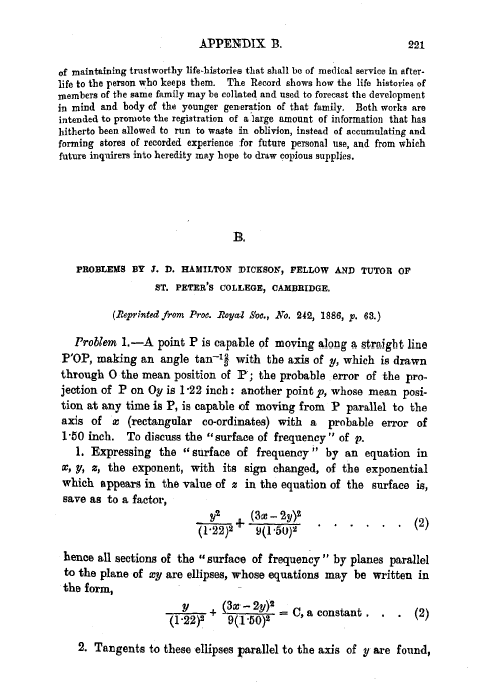APPENDIX B. 221
of maintaining trustworthy life-histories that shall be of medical service in afterlife to the person who keeps them. The Record shows how the life histories of members of the same family may be collated and used to forecast the development in mind and body of the younger generation of that family. Both works are intended to promote the registration of a large amount of information that has hitherto been allowed to run to waste in oblivion, instead of accumulating and forming stores of recorded experience for future personal use, and from which future inquirers into heredity may hope to draw copious supplies.
B.
PROBLEMS BY J. D. HAMILTON DICx8ON, FELLOW AND TUTOR OF
ST. PETER'S COLLEGE, CAMBRIDGE.
(Reprinted front Pree. Royal Soe., No. 242, 1886, p. 63.)
Problem 1.-A point P is capable of moving along a straight line FOP, making an angle tan-12 with the axis of y, which is drawn through 0 the mean position oaf P'; the probable error of the projection of P on Oy is 122 inch : another point p, whose mean position at any time is P, is capable of moving from P parallel to the axis of x (rectangular co-ordinates) with a probable error of 1.50 inch. To discuss the "surface of frequency " of p.
1. Expressing the " surface of frequency " by an equation in x, y, z, the exponent, with its sign changed, of the exponential which appears in the value of z in the equation of the surface is, save as to a factor,
e + (3x - 2y)2 (2) (1-22), 9(1 50)2'
hence all sections of the "surface of frequency" by planes parallel to the plane of xy are ellipses, whose equations may be written in the form,
(1 22)2 + (9(l. 0)22 - C, a constant . (2)
2. Tangents to these ellipses parallel to the axis of y are found,

